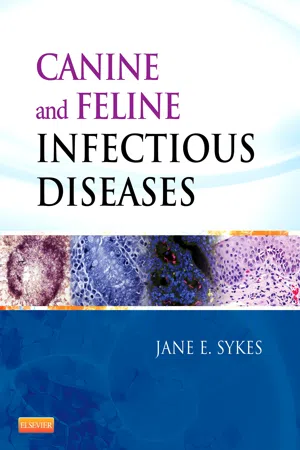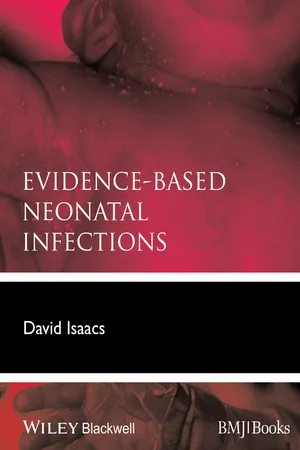Biological Sciences
Bacterial Meningitis
Bacterial meningitis is a serious infection of the protective membranes covering the brain and spinal cord. It is caused by various bacteria, with symptoms including severe headache, fever, and stiffness in the neck. Prompt diagnosis and treatment with antibiotics are crucial to prevent potential complications such as brain damage or even death.
Written by Perlego with AI-assistance
Related key terms
5 Key excerpts on "Bacterial Meningitis"
- eBook - ePub
Infections of the Central Nervous System
Pathology and Genetics
- Katy Keohane, Francoise Gray, Fabrice Chretien, Kum Thong Wong, Leroy R. Sharer(Authors)
- 2020(Publication Date)
- Wiley-Blackwell(Publisher)
30 Pyogenic Infections of the CNS 1 : Acute Bacterial Meningitis Loic Le Guennec1,2 and Sandrine Bourdoulous11 Inserm, U1016, Institut Cochin, CNRS, UMR8104, Paris University, Paris, France2 La Pitie‐Salpetriere Hospital, APHP, Paris, FranceAbbreviations
BBBblood‐brain barrierBMBacterial MeningitisCNScentral nervous systemCSFcerebrospinal fluidDICdisseminated intravascular coagulationE. coliEscherichia coliEEGelectroencephalographyEoDearly‐onset diseaseGBSgroup B StreptococcusHibHaemophilus influenzae type b:L. monocytogenesListeria monocytogenesLoDlate‐onset diseaseLPLumbar punctureMRImagnetic resonance imagingM. tuberculosisMycobacterium tuberculosisNCAMneural cell adhesion moleculeN. meningitidisNeisseria meningitidisPCRpolymerase chain reactionPCV1313‐valent pneumococcal conjugate vaccinePMNLpolymorphonuclear leukocytesPPV2323‐valent pneumococcal polysaccharide vaccineIntroduction, definition, and historical perspective
Bacterial Meningitis (BM ) is an acute purulent infection of the meninges. It is the most common bacterial infection of the CNS and is a medical emergency that still has a high mortality and morbidity despite the overall improvements in its diagnosis and management. BM is one of the top 10 causes of infection‐related deaths worldwide, and about 40% of the survivors suffer neurological sequelae [1 ]. Hippocrates described meningitis 25 centuries ago [2 ], but the first described meningitis outbreak was in Geneva in 1805. An African outbreak was reported in 1840. One of the main causative bacteria, Neisseria meningitidis, was described by Anton Weichselbaum, an Austrian pathologist in 1887 (which he named “Diplococcus intracellularis meningitidis”) [3 ]. The clinical features were described by Kernig, a Russian neurologist in 1884, and later by Brudinski, a Polish physician. Both their names are associated with the classical signs of testing resistance to stretching of the inflamed meninges [4 ]. Meningococcal vaccine was developed in the 1970s and since then, vaccines have been introduced for several serotypes of meningococcus, pneumococcus, and other causes of BM (e.g.Haemophilus influenzae b[Hib - eBook - ePub
- Jane E. Sykes(Author)
- 2013(Publication Date)
- Saunders(Publisher)
Chapter 90Bacterial Meningitis
Craig E. GreeneOverview of Canine and Feline Bacterial MeningitisCause: Bacterial Meningitis is caused by a variety of pyogenic bacteria that enter the subdural space. Organisms are usually microfloral species or from environmental contamination of penetrating objects.Affected Hosts: Dogs and cats of all ages are affected. Geographic Distribution: WorldwideMode of Transmission: Bacteria can spread to the meninges from (1) sites of infection in the nasal sinuses, retrobulbar tissues, or middle or inner ear when host immune defenses are compromised; (2) sites of traumatic focal penetration; (3) sites of infection in adjacent venous sinuses or bony structures; or (4) via hematogenous arterial dissemination.Major Clinical Signs: Fever, reluctance to move, stiff gait, and muscle spasms are the most common clinical signs. Paraspinal hyperesthesia and progressive neurologic dysfunction are progressive features.Differential Diagnoses: Meningeal inflammation caused by nonbacterial microorganisms and immune-mediated causes should be considered. Myeloid or lymphoid neoplasias that affect the meninges may cause similar diffuse signs of inflammation.Human Health Significance: None. The organisms that cause Bacterial Meningitis are indigenous microflora or environmental contaminants. Precautions should always be taken in collecting or handling cerebrospinal fluid potentially laden with microorganisms during diagnostic medical procedures.Etiology and Epidemiology
Bacterial Meningitis involves inflammation of the subdural covering of the brain and spinal cord, including the arachnoid membrane, subarachnoid space, pia mater, and cerebrospinal fluid (CSF), in response to a bacterial infection. The subarachnoid space projects into the nervous tissue alongside penetrating blood vessels. Bacterial infections can spread into the meningeal spaces from natural orifices such as the nasal sinuses, retrobulbar tissues,1 -3and middle or inner ear.4 Bacteria that proliferate in middle or inner ear infections can enter the cranial vault and produce cranial meningitis or subdural abscess formation (empyema) and, frequently, central vestibular dysfunction.5 -8Bacteria can also enter the meningeal spaces through traumatic focal penetration (foreign bodies or bite wounds),9 ,10spread from sites of infection in adjacent venous sinuses or bony structures, or spread via hematogenous arterial dissemination.11 ,12 - eBook - ePub
- Jane E. Sykes, Craig E. Greene(Authors)
- 2013(Publication Date)
- Saunders(Publisher)
Chapter 91 Bacterial Infections of the Central Nervous System Marc Kent References Images Web Tables, Boxes, and Appendices Etiology Central nervous system (CNS) inflammation is described as encephalitis, myelitis, and meningitis based on whether the process affects the brain, spinal cord, or meninges, respectively. Inflammation in the CNS may be the result of an infectious process, immune-mediated inflammation in the absence of infection, neoplasia, trauma, or infarction. The underlying pathogenesis of immune-mediated disease is often unknown. Granulomatous meningoencephalitis (GME) is a classic example of an immune-mediated process without a determined cause. 30 Other immune-mediated diseases preferentially affect certain breeds. Breed-specific inflammatory disease has been identified in the pug dog, 53 Maltese terrier, 236 Yorkshire terrier, 249 Pekingese, 41 and greyhound, 38 and Chihuahua. 106 Other immune-mediated diseases such as steroid-responsive meningitis-arteritis typically affect young patients, usually under the age of 2 years. 160 See Chapter 82 for more information on the inflammatory diseases described previously. Alternatively, immune-mediated disease is sometimes categorized based on the principal inflammatory reaction, GME, 30 or eosinophilic meningoencephalitis. 227 Chemical meningitis can be induced by the subarachnoid injection of contrast agents as is seen with myelography. 42 Finally, some neoplasms such as meningioma have been associated with an inflammatory response. 14, 43, 64 Infectious diseases that affect the CNS include viral, protozoal, fungal, rickettsial, and bacterial organisms. 28, 88, 96, 135, 172 Some viruses (canine distemper virus [CDV; Chapter 3 ] and rabies virus [ Chapter 20 ]) are neurotropic, as are some protozoans such as systemic amebic infections (Chapter 78) and Toxoplasma gondii and Neospora caninum (Chapter 79) - Randall T. Hayden, Karen C. Carroll, Yi-Wei Tang, Donna M. Wolk(Authors)
- 2016(Publication Date)
- ASM Press(Publisher)
References
1. Radetsky M . 2014. Fulminant Bacterial Meningitis. Pediatr Infect Dis J 33 : 204–207.[PubMed] [CrossRef]2. Mook-Kanamori BB , Geldhoff M , van der Poll T , van de Beek D . 2011. Pathogenesis and pathophysiology of pneumococcal meningitis. Clin Microbiol Rev 24 : 557–591.[PubMed] [CrossRef]3. Le EM , Loghin ME . 2014. Posterior reversible encephalopathy syndrome: a neurologic phenomenon in cancer patients. Curr Oncol Rep 16 : 383. [PubMed] [CrossRef]4. Pruitt AA , Graus F , Rosenfeld MR . 2013. Neurological complications of solid organ transplantation. Neurohospitalist 3 : 152–166.[PubMed] [CrossRef]5. Bruner KE , Coop CA , White KM . 2014. Trimethoprim-sulfamethoxazole-induced aseptic meningitis–not just another sulfa allergy. Ann Allergy Asthma Immunol 113 : 520–526.[PubMed] [CrossRef]6. Capone PM , Cohen ME . 1991. Seizures and cerebritis associated with administration of OKT3. Pediatr Neurol 7 : 299–301.[PubMed] [CrossRef]7. Heckenberg SG , Brouwer MC , van de Beek D . 2014. Bacterial Meningitis. Handb Clin Neurol 121 : 1361–1375.[PubMed] [CrossRef]8. Pruitt AA . 2012. CNS infections in patients with cancer. Continuum 18 : 384–405.[PubMed] [CrossRef]9. Safdieh JE , Mead PA , Sepkowitz KA , Kiehn TE , Abrey LE . 2008. Bacterial and fungal meningitis in patients with cancer. Neurology 70 : 943–947.[PubMed] [CrossRef]10. Tunkel AR , Hartman BJ , Kaplan SL , Kaufman BA , Roos KL , Scheld WM , Whitley RJ . 2004. Practice guidelines for the management of Bacterial Meningitis. Clin Infect Dis 39 : 1267–1284.[PubMed] [CrossRef]11. Swanson PA 2nd , McGavern DB . 2015. Viral diseases of the central nervous system. Curr Opin Virol 11C : 44–54.[PubMed] [CrossRef]12. Zunt JR , Baldwin KJ . 2012. Chronic and subacute meningitis. Continuum- eBook - ePub
- David Isaacs(Author)
- 2013(Publication Date)
- Wiley-Blackwell(Publisher)
CHAPTER 7 Bacterial Meningitis 7.1 EpidemiologyBacterial Meningitis is more common in the neonatal period than at any other age.1-3 A review of the epidemiology of neonatal Bacterial Meningitis found two non-Cochrane reviews of neonatal meningitis in Western countries1,2 and one in developing countries.3 This chapter will concentrate on Bacterial Meningitis (see Chapter 16 for fungal meningitis, Chapter 17 for viral meningitis and Chapter 18 for tuberculous meningitis).7.1.1 IncidenceThe reported incidence of neonatal meningitis varies with diagnostic practice, changes in prevalent organisms, rates of prematurity and the use of intrapartum maternal antibiotic chemoprophylaxis to reduce GBS infection. In the United Kingdom, the rate of neonatal meningitis was 0.4–0.5 cases/1000 in the 1970s,4,5 but fell to 0.21–0.25/1000 live births in the 1980s and 1990s.6-8 A US study reported a similar incidence of 0.25 cases/1000 live births from 1988–1992.9 In Australia in the 1980s, the reported rate was 0.17 cases/1000 live births.10Reports do not always distinguish early- from late-onset meningitis. The rate of early-onset meningitis in Australia from 1992–2002 was 0.11 per 1000 live births, but was 1.1 per 1000 infants <;1500 g.11 The proportion of US infants <;1500 g who survived at least 3 days and developed late-onset meningitis was 1.4%.12 High-risk populations may have an even higher incidence even if not so premature: 1% of neonates >34 weeks managed on US neonatal intensive care units developed meningitis, presumably because the population included infants with other risk factors.13The incidence in developing countries is almost certainly higher than in Western countries but the data are subject to considerable uncertainty. As pointed out by the authors of a systematic review,3 studies may define the ‘neonatal period’ as up to 30, 60 or 90 days. Because most births in developing countries occur at home and deaths are under-reported, the true incidence and mortality of neonatal meningitis is probably a lot higher than reported. A review of evidence from community-based studies in developing countries found a reported incidence of neonatal meningitis that varied from 0.8 per 1000 live births in the first week of life to 6.1 per 1000 live births overall.14
Learn about this page
Index pages curate the most relevant extracts from our library of academic textbooks. They’ve been created using an in-house natural language model (NLM), each adding context and meaning to key research topics.




